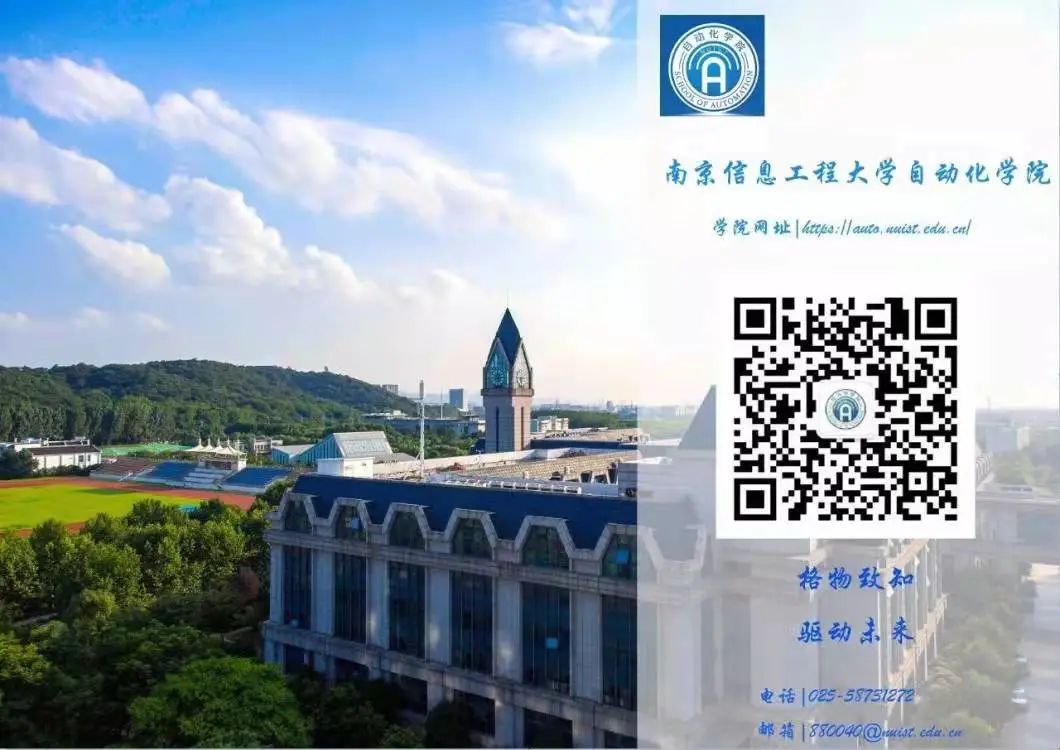What is an FPGA Chip
Integrated circuit chips include two main categories: digital chips and analog chips. Digital chips can be further divided into memory chips and logic chips. The logic chips we are familiar with generally include general-purpose processor chips such as CPUs, GPUs, DSPs, as well as Application-Specific Integrated Circuits (ASICs). FPGA (Field Programmable Gate Array) is also a type of logic chip.
 Classification of Digital Chips
Classification of Digital Chips
FPGA is a product developed further based on traditional logic circuits and gate arrays such as PAL (Programmable Array Logic), GAL (Generic Array Logic), and CPLD (Complex Programmable Logic Device). It utilizes computer-aided design to draw schematics, edit Boolean equations, or use hardware description languages as design inputs. After a series of transformation programs, automatic layout routing, and simulation processes, FPGA data files are generated to initialize the FPGA device. This achieves a dedicated integrated circuit that meets user requirements, truly allowing users to design, develop, and produce integrated circuits themselves.
The core difference between FPGA and chips like CPU, GPU, and ASIC is that the wiring and logical layout of its underlying logic operation units are not fixed. Users can program the logic units and switch arrays through EDA software for functional configuration, thereby achieving integrated circuit chips with specific functionalities. In contrast, other types of logic chips, such as ASICs, CPUs, and GPUs, have fixed and unchangeable operational relationships among their physical underlying logic units. Simply put, while CPUs, GPUs, and ASICs are like completed buildings with fixed layouts for rooms, corridors, and stairs, the internal structure of an FPGA resembles the magical staircases in Hogwarts, which can change the route between rooms at any time.
FPGA consists of three types of programmable circuits: Configurable Logic Blocks (CLB), Input/Output Modules (IOB), and Programmable Interconnect Resources (PIR), along with Static Random-Access Memory (SRAM) used to store programming data. CLB is the basic unit for implementing logical functions, typically arranged in a regular array scattered throughout the chip. IOB primarily interfaces the chip’s logic with external pins, usually arranged around the chip’s perimeter. PIR provides abundant wiring resources, including mesh wiring, programmable switch matrices, and programmable connection points, connecting various CLBs, IOBs, and between IOBs to form specific functional circuits. SRAM is used to store programming data for internal IOBs, CLBs, and PIRs, controlling them to complete system logic functions.
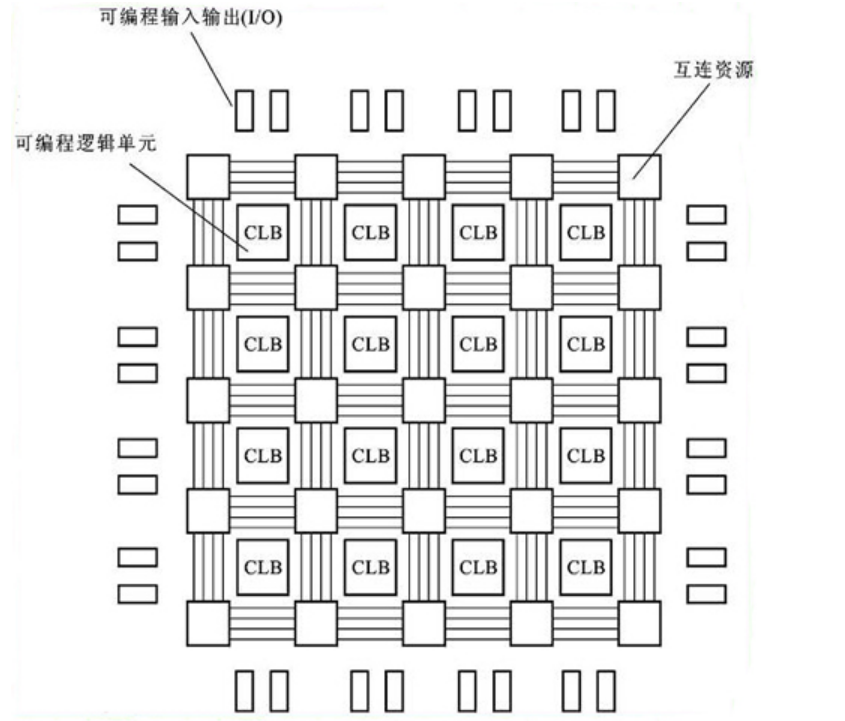
Basic Structure of FPGA
Due to the need for FPGA to be rewritten repeatedly, its combinational logic basic structure cannot be completed through fixed NAND gates but must adopt a structure that is easy to reconfigure. The Look-Up Table (LUT) can well meet this requirement.
LUT is essentially a RAM, where, after the user describes a logic circuit, the software calculates all possible results and writes them into the RAM. Each signal undergoing logical operations is equivalent to inputting an address to look up the table, finding the content corresponding to the address, and outputting the result. This also significantly speeds up the FPGA’s computation. Currently, mainstream FPGAs adopt a LUT structure based on SRAM technology, while some use Flash or antifuse technology for their LUT structure.
Summary
FPGA, or Field Programmable Gate Array, refers to a digital integrated circuit that can change and configure its internal connection structure and logic units through software means to achieve predetermined design functions.
FPGA belongs to the category of logic chips, and its biggest feature, distinguishing it from other logic chips, is its field programmability, which allows FPGA to implement the logical functions of any chip through programming, such as ASICs, DSPs, or even PC processors, which is why FPGA is called the “universal chip.”
For example, in logic chips, ASICs and DSPs are like a CD that comes pre-written with data and cannot be erased; users just need to play it in a CD player to listen to music. In contrast, an FPGA is like a blank CD that requires the user to burn data onto it using a burner, and the data can be erased and rewritten repeatedly.
FPGA Features
FPGA has three major features, one of which is the high programmability and flexibility mentioned above, while the other two are short development cycles and high parallel computing efficiency.
(1) Short Development Cycle
In logic chips, the manufacturing process for ASICs includes multiple steps like logical implementation, routing processing, and tape-out; however, FPGA does not require routing, masking, or custom tape-out, greatly simplifying chip development. Generally, logic chips like ASICs, DSPs, and SoCs have development cycles of 14-24 months or longer, while FPGA only requires 6-12 months, reducing the development cycle by 55% compared to other chips.
Table: Development Cycles of Logic Chips
|
Type |
FPGA |
ASIC |
DSP |
SoC |
|
Name |
Field Programmable Gate Array |
Application-Specific Integrated Circuit |
Digital Signal Processing Technology |
System on Chip |
|
Development Cycle |
6-12 months |
14-24 months |
14-24 months |
14-24 months or longer |
As the world’s largest FPGA manufacturer Xilinx believes, being faster is more important than being cheaper. If a product is 6 months late to market, it will reduce profits by 33% within 5 years, and every 4 weeks of delay equals a loss of 14% market share.
(2) High Parallel Computing Efficiency
FPGA belongs to parallel computing, meaning it can execute multiple instruction algorithms at once. In contrast, traditional ASICs, DSPs, and CPUs are serial computing, processing only one instruction set at a time. Therefore, for certain specific tasks, FPGA’s parallel computing efficiency is higher than that of serial computing.

Table: Comparison of Four Main Types of Chips
Application Scenarios
Due to its high programmability, short development cycle, and high parallel computing efficiency, FPGA has a particularly wide range of application scenarios.
FPGA can be applied in fields including network communication, consumer electronics, data centers, automotive electronics, and artificial intelligence. In China, FPGA is mainly used in the communication and industrial sectors, with the communication and industrial sectors accounting for 41.3% and 31.5% of FPGA usage in 2020.
Figure:2020 Distribution of FPGA Applications in China

According to Frost & Sullivan data, the market size of China’s FPGA market in 2020 was approximately 15.03 billion yuan, and it is expected to reach 33.22 billion yuan by 2025, with a compound annual growth rate of 17.2%.
Figure:2016-2025 Forecast of China’s FPGA Market Size

(1) Communication Field
The communication field is one of the major application markets for FPGA chips. Frost & Sullivan data shows that the sales of FPGA chips in this field in China will reach 6.21 billion yuan in 2020, accounting for 41.3% of China’s FPGA chip market share, with a compound annual growth rate of 17.5% from 2021 to 2025.
Figure: China’s FPGA Communication Market Size and Forecast
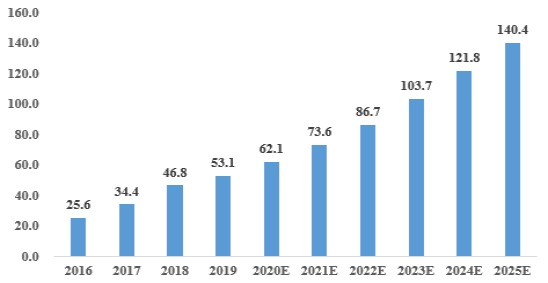
FPGA chips are currently widely used in wireless communication and limited communication devices to implement various functions such as interface expansion, logic control, data processing, and single-chip systems.
In wired communication, FPGA chips are applied in various circuit boards of data access, transmission, routers, and switches to achieve functions such as signal control and transmission acceleration.
In wireless communication, FPGA chips are used in various circuit boards of wireless communication base stations and RF processing units to achieve various functions of communication protocols and future upgrade requirements. Integrated CPU field programmable system-level chip products are used in outdoor micro base stations, indoor micro base stations, etc., to achieve diverse functional requirements such as multi-mode coverage, increased network capacity, and artificial intelligence computing in commercial, residential, and factory areas.
In the network communication field, FPGA chips are widely used mainly due to their high flexibility, strong real-time processing, and parallel processing capabilities, greatly enhancing the processing capabilities of communication devices.
(2) Industrial Field
The industrial field is another major application market for FPGA chips. Frost & Sullivan data shows that the sales of FPGA chips applied in this field in China will reach 4.74 billion yuan in 2020, accounting for 31.5% of China’s FPGA chip market share, with a compound annual growth rate of 16.1% from 2021 to 2025.
Figure: China’s FPGA Industrial Market Size and Forecast
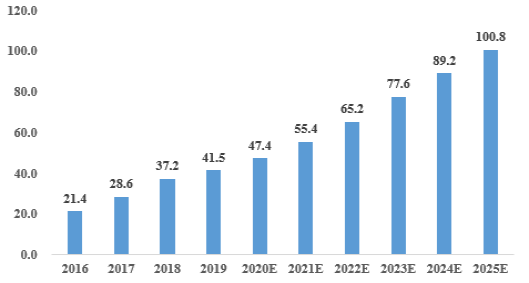
Data Source: Anlu Technology Prospectus
FPGA is mainly applied in the industrial field for video processing, image processing, CNC machine tools, etc., to achieve signal control and computational acceleration. With the development of intelligent and automated technologies, the industrial field is gradually shifting from a human resource-driven core to an automated core in smart factories.
Benefiting from the trend of industrial intelligence and automation, the high efficiency, real-time performance, and high flexibility of FPGA chips have led to their wide application in the industrial field. For example, in the servo system of CNC machine tools, compared to traditional dedicated chips that can only control a single motor, FPGA chips can control multiple channels of motors.
(3) Data Centers
Data centers are an emerging application market for FPGA chips. Frost & Sullivan data shows that the sales of FPGA chips applied in this field in China will reach 1.61 billion yuan in 2020, accounting for 10.7% of China’s FPGA chip market share, with a compound annual growth rate of 16.6% from 2021 to 2025.
Figure: China’s FPGA Data Center Market Size and Forecast
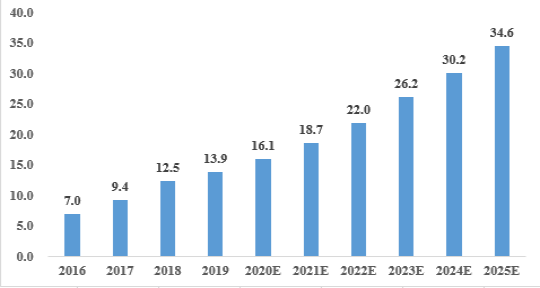
Data Source: Anlu Technology Prospectus
Data centers are specific device networks for global collaboration, used to transmit, accelerate, display, compute, and store data information over network infrastructure. Servers and storage are the general foundational devices of data centers. To cope with complex and variable application scenarios, FPGA chips are needed to achieve logical control, data conversion, functional expansion, and system upgrades.
In the data center computing processing field, compared to CPUs, FPGA chips can provide powerful computing power and sufficient flexibility due to their architecture that does not rely on instructions or shared memory. Compared to GPUs, FPGA chips have advantages of low latency and high throughput in data centers. Compared to ASICs, FPGA chips can achieve excellent balance in performance, flexibility, homogeneity, cost, and power consumption across five aspects.
FPGA chips are mainly used for hardware acceleration in the data center field. After replacing traditional CPU solutions with FPGA chips, significant acceleration effects can be achieved when processing custom algorithms. Therefore, starting in 2016, FPGA accelerators have been deployed on servers of Microsoft Azure, Amazon AWS, and Alibaba Cloud for computing acceleration.In the context of widespread cloud computing applications, future data centers will further increase their performance requirements for chips, leading to more data centers adopting FPGA chip solutions, which will enhance the value share of FPGA chips in data center chips.
(4) Automotive Electronics
The intelligence of automobiles opens up incremental space for FPGA. Frost & Sullivan data shows that the sales of FPGA chips applied in this field in China will reach 0.95 billion yuan in 2020, with a compound annual growth rate of 22.7% from 2021 to 2025.
Figure: China’s FPGA Automotive Electronics Market Size and Forecast
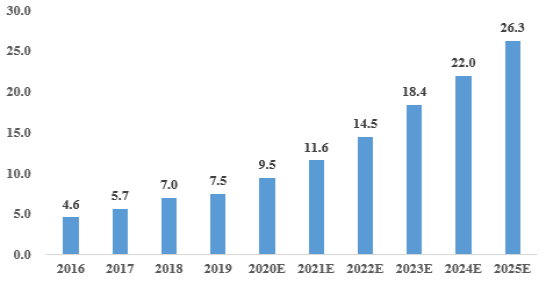
With the trend of intelligent development in automobiles, FPGA can be used to control and drive electric vehicle motor control systems, connecting various onboard devices such as driving systems, dashboards, radars, and ultrasonic sensors to achieve signal processing and control for laser radar, millimeter-wave radar, etc.
In the field of video bridging and fusion, FPGA can be used to implement signal bridging for multiple image sensors, 3D surround video fusion, reversing assistance video, and driver assistance video functions.
In the field of driver assistance and autonomous driving, FPGA can be used to implement machine vision and target detection functions. Compared to other general-purpose chip solutions, FPGA can employ ultra-low latency precise algorithms to analyze real-time video input signals from vehicle cameras, make timely judgments, and can be reprogrammed without redesign to adapt to evolving algorithms, thereby shortening the overall development cycle of the solution.
(5) Artificial Intelligence
Frost & Sullivan data shows that the sales of FPGA chips applied in this field in China will reach 0.58 billion yuan in 2020, with a compound annual growth rate of 16.9% from 2021 to 2025.
Figure: China’s FPGA Artificial Intelligence Market Size and Forecast
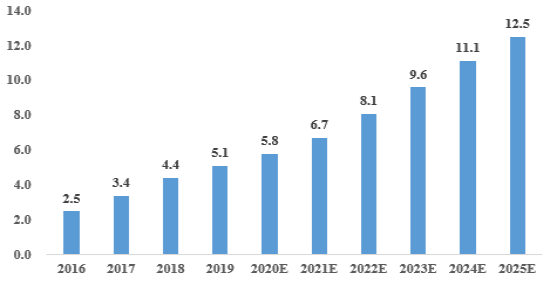
Data Source: Anlu Technology Prospectus
Artificial intelligence algorithm chips can be divided into cloud-side processing and edge-side processing. In cloud-side processing, compared to GPU and ASIC chips, FPGA chips can achieve true parallel computing due to their inherent parallel processing units reaching millions, and their programmability allows for flexible construction of data processing pipelines, making them fast in computation and low in data access latency, which is suitable for real-time decision-making needs in artificial intelligence.
In edge-side processing, FPGA chips can achieve rapid inference decisions. Additionally, their features of field programmability, customizable functions, high throughput, and low latency effectively meet user requirements for various neural network designs, making them ideal for adapting to various compressed and optimized neural network deployments and upgrades.
Foreign Giants Dominate the Domestic FPGA Market, Domestic Manufacturers Gradually Replace the Mid-Low-End Market
FPGA chips were developed earlier abroad and have a deep technical accumulation, resulting in a highly monopolized market. According to Frost & Sullivan statistics, based on shipment volume, over 80% of China’s FPGA chip market was occupied by foreign companies in 2019, with the top three suppliers being Xilinx, Intel, and Lattice, accounting for 36.6%, 25.3%, and 23.2% of the shipment volume, respectively. Domestic manufacturer Anlu Technology ranked fourth, with only a 6% share. If based on sales revenue, the market shows a dual oligopoly, with Xilinx and Intel’s combined market share reaching 91.1% in 2019, while Anlu Technology ranked fourth with a share of 0.9%, the highest among domestic manufacturers.
Figure:2019 China FPGA Chip Market Competition Landscape (Quantity)

Figure:2019 China FPGA Chip Market Competition Landscape (Sales Revenue)
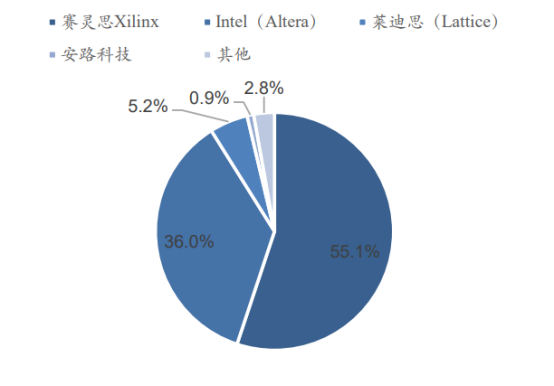
Currently, domestic manufacturers such as Anlu Technology, Unisoc, Fudan Microelectronics, Hygon Semiconductor, and Jingwei Technology have entered the FPGA industry. In recent years, due to the increasing restrictions imposed by the United States on China’s semiconductor industry, the urgent need for domestic FPGA replacement combined with the rapid iteration and expansion of domestic FPGA manufacturers’ products has led to a gradual realization of domestic substitution in the market for capacities below 500K and non-advanced processes.
FPGA chips with logic capacities below 100K and 100K-500K have a large demand and are the main market for domestic leading manufacturers to achieve domestic substitution.According to Frost & Sullivan data, in 2019, the market share of FPGA chips with logic capacities below 100K in China was 38.2%, while those with capacities between 100K-500K accounted for 31.7%. The segments of 500K-1KK and >1KK accounted for 24.4% and 5.7%, respectively. In terms of logic capacity, FPGA chips with capacities below 100K and 100K-500K are the most demanded in the Chinese market, and domestic manufacturers Anlu Technology and Unisoc have covered these segments, making them the main market for FPGA domestic substitution.
Figure:2019 Market Share of Various Logic Capacity FPGAs in China
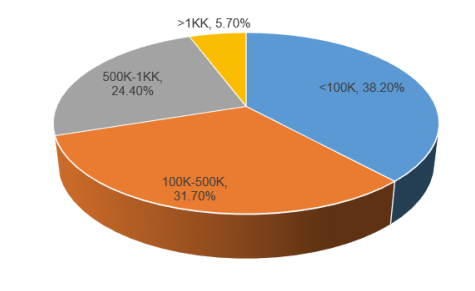
FPGA with processes above 28nm occupies a large portion of the market share and is an important direction for FPGA domestic substitution.From the perspective of process technology, due to the cost-effectiveness and yield advantages of 28nm-90nm process FPGAs, they hold a major market position. According to Frost & Sullivan data, in 2019, FPGAs with 28nm-90nm processes accounted for 63.3% of the Chinese market share, while FPGAs below 28nm accounted for 20.9%, and >90nm processes accounted for 15.8%. Due to restrictions on advanced process manufacturing in China, processes above 28nm are also an important direction for FPGA domestic substitution.
Figure:2019 Market Share of Various Industrial Processes FPGAs in China
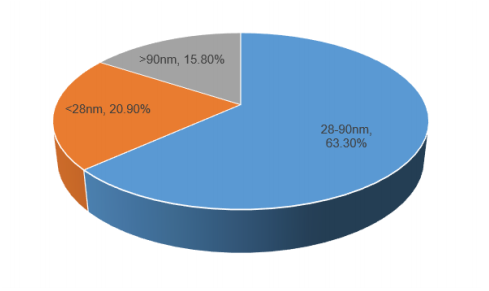
Conclusion
FPGA is also known as the “universal chip,” applicable across multiple industries. According to Frost & Sullivan data, the market size of China’s FPGA market in 2020 was approximately 15.03 billion yuan, and it is expected to reach 33.22 billion yuan by 2025, with a compound annual growth rate of 17.2%.
Currently, the domestic FPGA market is still monopolized by foreign giants, but in China, where capacities below 500K and non-advanced processes account for the majority of market share, domestic manufacturers’ products have gradually covered these fields, providing good development opportunities for domestic manufacturers.
Image and text source from Robot Network
Initial review: Tang Cuimei
Re-examination: Huo Xiaoyin
Final review: Wang Xianfang
